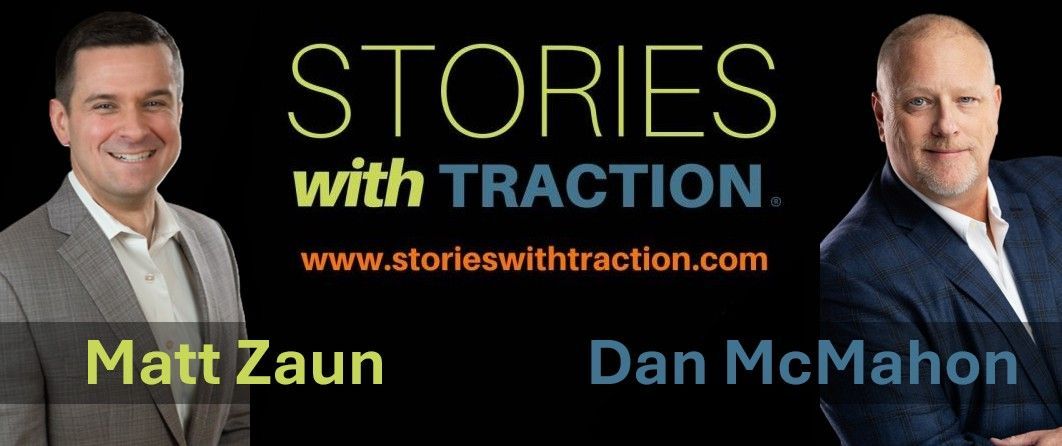5 Fortunes of CPA Firm Governance: a white paper
There is no “one size fits all” answer to designing and applying an effective governance model.
This whitepaper addresses five (among many) benefits of effectively deploying a governance structure in a CPA firm. We will first seek to provide a functional definition of governance that will then frame our deep dive discussion of the five benefits we’ve chosen to highlight.

Dan McMahon recently joined Matt Zaun on his "Stories with Traction" podcast to explore what happens when business leaders’ step outside their comfort zone and how those lessons translate into better leaders within their companies. It was a candid, energizing conversation about communication, culture, and courage, especially for leaders navigating growth and change. Here are three key takeaways from our conversation: Leadership requires risk Stepping into something uncomfortable, whether it’s public speaking, advisory work, or firm transformation, builds the credibility that inspires your team to follow. The strongest leadership happens when you demonstrate the courage to do things outside your comfort zone. We explore what happens when identity is too tightly tied to career success and why showing vulnerability can build trust. Humor is a leadership skill Matt and Dan unpack how using humor sharpens your business communication, breaks down barriers, and helps leaders to connect with people, and defuse tension when things get tough. Identity must evolve As your firm grows, so must your definition of personal success. The strongest leaders separate who they are from what they do, allowing room for growth and reinvention. Listen to the full episode here: Episode 170: Lessons from the CPA Who Took the Mic (and the Risk)

From CPA to Leadership and Growth Advisor: Insights from Dan McMahon on the Bee Formless Podcast with Belinda Murray In a recent episode of the Bee Formless podcast, host Belinda Murray sat down with Dan McMahon, founder of Integrated Growth Advisors (IGA), to explore his unique journey from a seasoned CPA to a leadership advisor who blends business strategy with innovative tactical solutions. Dan’s story offers valuable lessons for business leaders and entrepreneurs looking to grow their businesses while staying true to their personal and professional passions. Bee and Dan cover: Founding IGA: Embracing What Dan Loves to do Improv: More Than Just a Hobby; a new way to think and collaborate Integrated Growth Advisors: Helping Firms Grow with Purpose The Importance of Pausing, Reflecting, and Active Recovery Coaching and Continuous Growth For business leaders looking to elevate their businesses and themselves, Dan’s story is a powerful reminder that growth isn’t just about numbers—it’s about communication, strategy, mindset, execution, and leading with purpose. You can hear more of Dan’s insights on the Bee Formless podcast with Belinda Murray by clicking here: Yes-And Leadership: Stand-Up Courage & Freedom from the Grind with Dan McMahon, Flow Driven CEO - YouTube

As regular readers of this blog know, I’ve immersed myself in improv training for several years. Originally, I turned to improv to improve my public speaking and presentation skills. As an accounting firm partner who served in a leadership role, I used to get quite nervous when presenting to client boards, at firmwide meetings, or even to the firm’s management committee. That discomfort carried over early on to my current role as a management consultant where I must do more than my fair share of public speaking. Thanks to improv, I no longer feel anxious when at the podium for work or on-stage doing improv or something even scarier -- standup comedy. While I got involved with improv to overcome my fear of public speaking, it also made me a better listener and a more collaborative team player. Improv (aka improvisational theater) is a form of live performance in which actors create the characters, dialogue, and plot on the fly without a script. While it is often comedic, improv can also be used for dramatic or abstract performances. A pillar of improvisational theater is the concept of "Yes, and ...". That means an improviser should accept what another improviser has stated ("yes") and then expand on that line of thinking (by adding an "and"). The “Yes, and” principle can also used in business and in other fields for improving the effectiveness of the brainstorming process, for fostering effective communication, for encouraging the free sharing of ideas, and for driving collaboration among teams. When I’m in a boardroom speaking to a client, I must think on my feet. I must also learn to read the room, connect with the audience, listen intently, and craft appropriate responses to what’s being said. When doing improv, the audience shouts out a topic or an idea, and the performers must act out their own interpretation of the concept and set the table collaboratively so their fellow performers can build on what they’ve said. Learning how to handle spontaneous interruptions, whether on stage or in the boardroom, is an incredibly powerful skill to have in your arsenal. On stage, you never know what the audience will call out to you. You must stay in your element and listen carefully before responding. If you’re a CPA advising clients, there could be any number of curveballs thrown at you when you're in front of the management team reviewing financials, presenting a proposal, or delivering the findings of a report. Everybody has a unique perspective on what you’re delivering and you must be ready to digest that information – without taking it personally -- and respond in an intelligent, confident, and respectful manner. As accountants, we’re risk averse by nature. We try to eliminate as many unknowns and variables as possible. When preparing for a presentation, we spend countless hours trying to anticipate every question or criticism that’s likely to come our way. I get it. Nobody likes to feel foolish or unprepared. But improv trains you to do the opposite: Don’t come in over-prepared. Just get better at being able to think on your feet and building off what the audience is throwing at you. Improv is not only a great skill to have for presentations and meetings, but also for job interviews, sales calls, networking events, podcast appearances, and even dating. Think about how much confidence you’ll have when you know you can go into any kind of unfamiliar situation – unprepared – and handle whatever comes your way without stammering, getting flustered or breaking out in a sweat. Real world example A few years ago, I was scheduled to present to a prominent CPA society. In my hotel room the night before the meeting, I sat down to review my slides one final time and suddenly realized the presentation was completely wrong for the intended audience. “I don't want to say this,” I told myself with dismay having worked incredibly hard on the presentation. “I don't think these people wants to hear this,” I told myself, as I felt that time was slipping away. So, I redid my entire slide deck between 4pm and 10pm the night before the meeting and showed up the next day without rehearsing the new deck. My improv training kicked in and I just rolled with it. In fact, I was more relaxed than usual. I wasn’t trying to remember my lines; I was just in the moment, reacting to what the audience was asking me and reading their body language. Long story short, the presentation went very well and I ended up with two new clients and several connections. Improv for strategic planning and leadership When helping clients with their strategic planning we always start with a blank whiteboard and blank sheets of paper. You never know what's going to come up when you're standing in front of a management team. There’s usually some hesitation from the participants. Then somebody says something, another person echoes that sentiment and you've got to think on your feet, categorize the information and communicate with the group. You also need to respect each person’s unique input—whether it’s on point or not -- and navigate the discussion knowing that nobody is perfect. Improv helps with that. Leaders and teams increasingly face situations without clear precedents. Improv helps train you to be in the moment, making decisions without a script, shifting gears quickly and innovating on the spot, since you must build only on the materials put in front of you. The key is to avoid being a “ yes, but’er, ” which essentially is a conversation breaker. Alternatively, say “Yes, And” – with the intent of being additive rather than dismissive or cynical. Getting Started with Improv Improv can be extremely effective for collaboration and teamwork. Try it at your next offsite meeting. I recommend starting with a trained facilitator or take your team to a local improv theater and have an instructor guide you. You can also encourage team members to take improv classes individually. After some initial reluctance, your team won’t ever look at each other the same way again – they’ll have a much deeper understanding of each other that’s very different from where they sit on the org chart. Conclusion If you need help finding an improv trainer or class, or just want to learn more about the process, contact me any time. I’m happy to help.

Let’s get one thing straight: CEOs don’t suffer from a shortage of ideas. They suffer from a shortage of focus. It’s not always a strategy issue. It’s not always a talent issue. It’s oftentimes a focus issue. A recent study by Harvard Business Review tracked large-company CEOs over a 13-week period and found that the average leader spends 36% of their time reacting to unexpected issues, with only 11% on routine duties tasks that could typically be delegated. I talk to business owners every day who are stuck. Not because their companies aren’t growing, many are. They’re feeling stuck because they’re adding work, not value. The business is expanding, but they’re more exhausted than ever, buried in distractions, unsure if their time is making the impact that it should. If that sounds familiar, here’s the hard truth: your business can’t outgrow your lack of clarity. Growth is a Focus Problem, Not a Capacity Problem Many leaders think the answer to growth is more: more marketing, more meetings, more tools, more talent, more money. But the real answer the one that actually works is less. Less noise. Less chaos. Less doing. You scale not by doing more, but by doing less better. And it starts at the top. If the CEO isn’t focused, no one else will be. Compartmentalize to Multiply We help leaders grow by helping them focus. And the key to helping them focus is breaking the business into five essential parts: 1. Sales & Marketing 2. People & HR 3. Admin & Finance 4. Client Delivery 5. Owner Initiatives Everything that happens in your company lives inside one of these five areas above. Once you compartmentalize, you can prioritize. Once you prioritize, you can delegate. And once you delegate, you can finally do what only you can do: drive the strategies and tactics that will make your business a success in the minds of its stakeholders. That's the essence of what we call *highest and best use* getting you, your team, and your systems aligned with the work that drives real value. Clarity is a System, Not a Slogan Once your business is broken into these parts, it becomes easier to implement clarity across three crucial dimensions: 1- Roles & Responsibilities – Is everyone clear on what they own? 2- Policies & Procedures – Are there repeatable systems in place? 3- Metrics & Goals – Is performance defined, measured, and aligned? When those elements are murky, teams spin. When they’re clear, the machine runs. The Real CEO Job Too many business owners are still in the weeds, wearing too many hats, babysitting every decision. That’s not leadership it’s firefighting disguised as hard work. Your real job as CEO isn’t to run every department and put out every fire. It’s to *create focus*. Focus for yourself. Focus for your team. Focus on the right things, at the right time, with the right people. So What’s the Next Step? If you feel like your growth is costing you clarity, or your role is expanding while your impact shrinks we have a tool that might help. It’s called the Growth & Value Assessment . It’s completely free and takes only 15 minutes to complete. The assessment will help you identify areas where your business may be scattered… and where you need to improve your focus. Because once you fix your focus, everything else will fall into place.

Most firms don’t fail at M&A because of bad intentions. They fail because they didn’t know what they didn’t know. If you're a CPA firm leader thinking about buying or selling a firm but you're not sure where to start or what traps to avoid you're not alone. M&A gets talked about as a strategic growth lever or a retirement solution. But when it shows up in real life, it’s rarely smooth or simple. Deals stall. Cultures clash. Clients leave. Partners second-guess each other. Whether you're considering selling your firm or acquiring another, there’s a good chance you’ve already felt some of the friction. Below are a few of the most common concerns we see and a way to gauge how prepared you really are. If You’re Considering Selling, How True Are These Statements? I have no idea what my firm is actually worth. What if my clients or staff leave when I start to step back? I don’t have a clear successor and I’m getting tired. I’m too busy running the firm to even think about selling it. If you nodded to two or more, your firm may not be sale-ready yet. But you’re asking the right questions. If You’re Considering Buying, How True Are These? We want to grow, but the right deals just aren’t out there. The last firm we bought was chaos to integrate. I’m worried we’ll overpay and lose clients anyway. Our partners can’t agree if we should even be doing this. If your head nodded on a few of those, you might have the desire but not the alignment, strategy, or infrastructure to move forward confidently. And Then There’s the Universal Stuff Buyer or Seller: We don’t have a real M&A process we’re just winging it. We’re afraid of making a bad deal that messes up the culture. We don’t have anyone we trust to guide us through this. Even one or two “yes” answers here should prompt a deeper pause. The stakes are too high to fake your way through this. So, What Now? Try this quick self-check: Count how many of the above statements you answered “yes” to. 0–2: You may be in good shape, but a second opinion never hurts. 3–5: There are likely gaps worth addressing before you proceed. 6+: You’re not alone. Many firms start here. Now is a great time to step back and build a clearer roadmap. You don’t need to have all the answers. But you do need to ask the right questions before signing a letter of intent. If this helped you think through things more clearly even a little then it’s done its job. If you'd like a simple checklist to evaluate your M&A readiness, just reach out to me at dmcmahon@integratedgrowthadvisors.com We’ve built one specifically for CPA firms to help avoid the common pitfalls. It's our mission to support CPAs in making better decisions and it's my pleasure to provide the checklist with no strings attached.

If you think being a great CPA or business advisor in the AI era is about learning to code or installing some new software, think again. Soft skills are increasingly valued over technical skills. I will share 10 of the most important ones with you shortly. In many ways this transformation in our profession reminds me of the early settlers who stepped off the boat at Jamestown in 1607—unfamiliar land, unknown threats, and zero guarantees. The ones who survived weren’t the smartest or most educated. They were the most adaptable. They reinvented themselves or they didn’t make it. That’s where we are today in the CPA profession.

A few days ago, I stepped onto a stage for the first time as a stand-up comedian. I’ve spent years doing improv, but stand-up is different. Stand-up isn’t about reacting in the moment; it’s about crafting, refining, and delivering material in a way that resonates (hopefully) with an audience that wants to be entertained. I learned a ton from my stand-up classes and first performance and a great deal of what I learned can be applied directly to business leadership. Here are the three biggest lessons that business leaders can learn from stand-up comedy:




